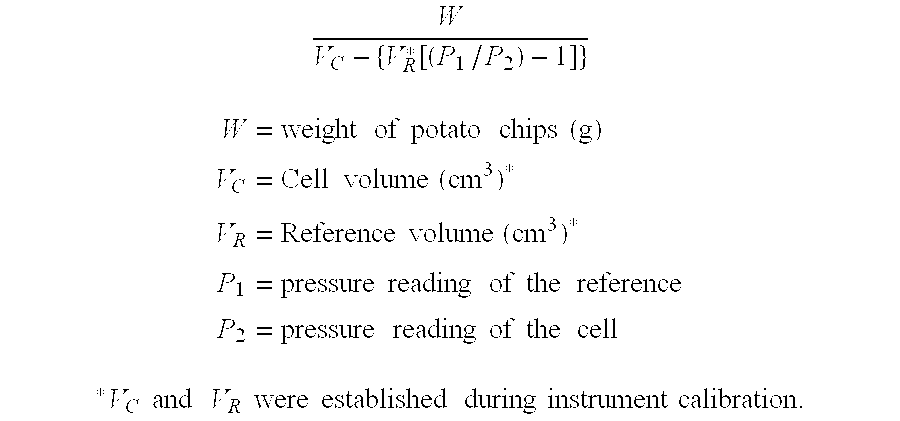Methods of making snack food products and products made thereby
- Summary
- Abstract
- Description
- Claims
- Application Information
AI Technical Summary
Benefits of technology
Problems solved by technology
Method used
Image
Examples
example 1
[0098]Potato Chips: Approximately 2,333 grams of Yukon Gold variety potatoes were washed, then sliced to an average slice thickness of 1.90 mm, yielding approximately 2288 grams of sliced potatoes. The sliced potatoes were rinsed for 15 seconds in cold water (18° C. / 65° F.) and drained. The drained potato slices were placed in a solution of 0.5% amylase (American Labs, Inc. Fungal Amylase-100,000 SKB / gram Lot ALI00517-04) and 1% aqueous Calcium Chloride (32% aqueous solution Calcium Chloride from DSM Food Specialties) and held for 3 minutes before draining. After draining, the treated potato slices were blanched in 93° C. (200 degrees F.) water containing 3% salt (NaCl) (Cargill Top Flow Salt) for 1 minute. Blanched potato slices were dipped into cold water for about 15 seconds to halt cooking, then drained. The potato slices were then placed directly on a conveyor belt of an impingement oven (Impinger® I, Model No. 1240 from Lincoln Food Service Products, Inc., Fort Wayne, Ind.) se...
example 2
[0108]Regular Fat-Free Potato Sticks: Russet Burbank Potatoes were peeled and cut Julienne style lengthwise to achieve approximately 2 mm height and width. After slicing 540 grams of these, the raw potato sticks were rinsed for under 65° F. running water for 15 seconds. Then the rinsed sticks were held in a solution containing 500 grams water (43° C. / 110° F.), 5 grams bacterial amylase (Lot No. ALI05175-04, American Laboratories, Inc.), 5 grams calcium chloride solution (32% solution Calcium Chloride from DSM Food Specialties) for 3 minutes. The enzyme treated potato sticks were drained, then blanched in 87° C. / 190° F. water containing 3% Cargill Sea Salt (3000 g cold water, plus 90 g salt) for 1 minute 30 seconds before draining. Blanched potato sticks were placed directly on perforated aluminum tray and put into an impingement oven (Impinger® I, Model No. 1240 from Lincoln Food Service Products, Inc., Fort Wayne, Ind.) set at 140° C. / 285° F. Oven belt speed was set at 24 minutes. ...
example 3
[0109]Larger Size, Puffed Potato Strips: Yukon Gold potatoes were peeled and cut slices approximately 2 mm thick. These slices were then cut into strips approximately 6 mm wide. Approximately 750 grams of these raw potato strips were rinsed under 65° F. running water for 15 seconds. Then the rinsed strips were held in a solution containing 500 grams water (43° C. / 110° F.), 5 grams bacterial amylase (Lot No. ALI05175-04, American Laboratories, Inc.), 5 grams calcium chloride (32% solution Calcium Chloride from DSM Food Specialties) for 3 minutes. The enzyme treated potato strips were drained, then blanched in 87° C. / 190° F. water containing 3% Cargill Sea Salt (3000 g water, plus 90 g salt) for 1 minute 30 seconds before draining. The blanched potato strips were placed directly on perforated aluminum tray and put into an impingement oven (Impinger® I, Model No. 1240 from Lincoln Food Service Products, Inc., Fort Wayne, Ind.) set at 135° C. / 275° F. Oven belt speed was set at 27 minute...
PUM
 Login to View More
Login to View More Abstract
Description
Claims
Application Information
 Login to View More
Login to View More - R&D
- Intellectual Property
- Life Sciences
- Materials
- Tech Scout
- Unparalleled Data Quality
- Higher Quality Content
- 60% Fewer Hallucinations
Browse by: Latest US Patents, China's latest patents, Technical Efficacy Thesaurus, Application Domain, Technology Topic, Popular Technical Reports.
© 2025 PatSnap. All rights reserved.Legal|Privacy policy|Modern Slavery Act Transparency Statement|Sitemap|About US| Contact US: help@patsnap.com

